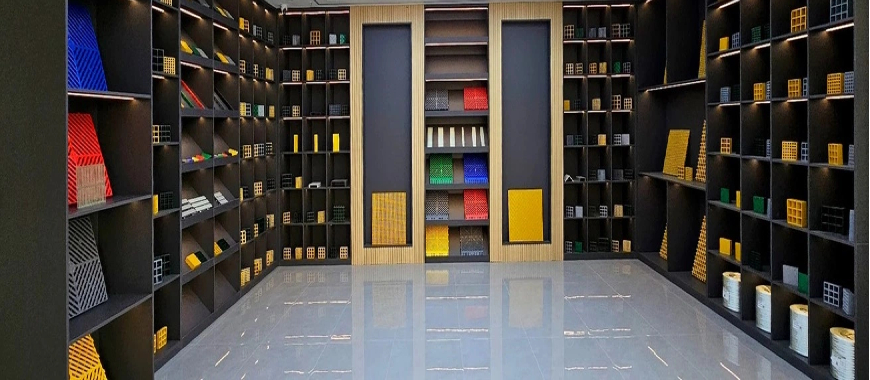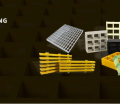
Polymer grating is a structured panel made from polymer-based materials designed for industrial, commercial, and residential applications. It offers a lightweight, non-corrosive alternative to metal gratings, ensuring long-lasting performance in harsh environments. The open grid design in polymer grating provides excellent drainage and ventilation, making it ideal for wet areas.This material is widely used in industries such as manufacturing, construction, and marine, where strength and durability are essential. Applications include walkways, platforms, trench covers, and floor grating. Polymer grating is also preferred in public spaces due to its non-slip surface, ensuring pedestrian safety.Compared to traditional metal grating, polymer grating offers superior corrosion resistance, requires less maintenance, and remains non-conductive, reducing safety risks in sensitive environments.
Key Features of Polymer Grating
Polymer grating offers several valuable properties that make it a preferred choice across industries. With corrosion resistance, lightweight construction, and non-conductive surfaces, polymer grating outperforms traditional materials like steel or aluminum in various environments. Below is a detailed exploration of the key features.
Corrosion Resistance and Lightweight Properties
- Polymer grating withstands exposure to chemicals, moisture, and saltwater without degrading.
- Lightweight structure makes it easier to install and transport, reducing labor costs.
- Ideal for outdoor environments, including marine settings, wastewater plants, and industrial factories.
Non-Conductive and Non-Sparking Surfaces
- Polymer grating ensures electrical safety by preventing conductivity, making it suitable for environments with sensitive equipment.
- Non-sparking surfaces reduce the risk of fire hazards in areas with flammable gases.
- Recommended for applications in power plants, chemical facilities, and refineries.
High Strength and Durability Under Heavy Loads
- Polymer grating can support significant weight, ensuring durability in heavy-duty industrial environments.
- High impact resistance prevents cracking or breaking under mechanical stress.
- Used for walkways, platforms, and loading areas where strength is crucial.
Low Maintenance with Anti-Skid Capabilities
- The anti-skid surface ensures safety for pedestrians and workers, even in wet conditions.
- Polymer grating requires minimal maintenance due to its corrosion-resistant properties.
- Commonly used in public areas and industrial walkways for enhanced safety and reduced maintenance costs.
Exploring the Polymer Grating Price Range
Understanding the price range of polymer grating is essential for budgeting and planning. Several factors influence the cost, making it important to evaluate options carefully.
Factors Influencing the Cost of Polymer Grating
- Material Composition: Higher-quality polymers or specialized coatings increase the price.
- Load Capacity Requirements: Gratings designed for heavy loads are typically more expensive.
- Custom Dimensions: Non-standard sizes and shapes add to the cost due to additional fabrication processes.
Comparison Between Bulk Purchases and Custom Sizes
- Bulk Purchases: Ideal for large projects, offering discounts per unit.
- Custom Sizes: Tailored dimensions fit specific spaces but come with higher costs and longer lead times.
Polymer Grating Suppliers and Availability
Sourcing polymer grating efficiently ensures timely project completion. Below are methods and tips for identifying reliable suppliers.
How to Source Polymer Grating Locally and Internationally
- Local Suppliers: Offer faster delivery and support, reducing lead times.
- International Suppliers: Provide access to a broader range of products and specialized grating solutions.
Tips for Choosing Reliable Suppliers
- Verify Certifications: Ensure the supplier meets industry standards and safety regulations.
- Assess Product Quality: Request samples to evaluate the durability and surface finish.
- Check Lead Times: Confirm delivery timelines align with your project schedule.
- Review Customer Feedback: Look for reviews from past clients regarding product performance and service.
- Inquire About Customization: Choose suppliers capable of offering tailored solutions.
- Evaluate After-Sales Support: Reliable suppliers provide ongoing maintenance services and technical support.
Why Choose Aluminum Floor Grating: Advantages and Uses
The Role of FRP Grating in Polymer Grating Solutions
FRP (Fiberglass Reinforced Plastic) enhances the performance of polymer grating, making it ideal for demanding environments.
How FRP Materials Enhance Grating Performance
- The combination of fiberglass and polymer ensures high strength without compromising flexibility.
- FRP grating offers superior corrosion resistance, ideal for marine and chemical industries.
- It provides excellent thermal insulation, maintaining stability in extreme temperatures.
Overview of Structural Uses for FRP Grating
- FRP grating is used in bridges, platforms, and industrial floors for its lightweight and durable nature.
- It serves as trench covers and drainage grates, ensuring safety and efficient water flow.
Overview of 4’x8 Fiberglass Grating Dimensions and Uses
The 4’x8 fiberglass grating size is a popular option for large-scale projects due to its versatility.
Benefits of Using 4’x8 Grating in Industrial Applications
- Its size reduces the need for multiple sections, simplifying installation.
- The fiberglass composition provides excellent resistance to rust and chemical exposure.
Ideal Settings for Large-Sized Fiberglass Grating
- Industrial platforms where a seamless surface is required.
- Walkways and bridges in corrosive environments, such as coastal areas and chemical plants.
Polymer Grating Near Me – Finding the Right Solution
At GangLong Fiberglass, we help clients find high-quality polymer grating solutions tailored to their needs. Our goal is to provide local access to premium products that meet industry standards.
Tips for Identifying Suppliers or Manufacturers Locally
- Search Nearby Industrial Parks: Many manufacturers operate in specialized industrial zones.
- Visit Trade Fairs and Expos: These events showcase suppliers offering polymer grating products.
- Consult Local Distributors: Distributors often carry various grating solutions for immediate delivery.
- Check Online Directories: Business directories list local suppliers with detailed product catalogs.
- Engage with Industry Networks: Professional networks can recommend trusted suppliers in your area.
Guide to Estimating Metal Grating Weight for Projects
Specialized Applications of Polymer Grating
Polymer floor grating offers unique benefits in diverse environments, ensuring safety, durability, and efficiency. Its lightweight design, non-slip surface, and high resistance to wear and weather make it an ideal choice across industrial and outdoor settings. Below is a detailed overview of how polymer floor grating enhances safety and reduces costs in different applications.
Polymer Floor Grating for Industrial Environments
Polymer floor grating plays a vital role in maintaining safety and efficiency in industrial spaces. Its unique properties address the specific challenges faced in manufacturing plants, warehouses, and processing facilities.
How Polymer Floor Grating Enhances Safety in Workspaces
- Prevents Slipping: The grating surface offers excellent traction, reducing the risk of slips and falls, even in wet conditions.
- Minimizes Fire Hazards: Polymer materials are non-sparking, making them ideal for environments with flammable gases or liquids.
- Prevents Electrical Accidents: The non-conductive surface of polymer grating reduces the risk of electrical hazards in areas with heavy machinery.
- Improves Drainage: The open grid design allows fluids to drain efficiently, keeping floors dry and safe.
- Enhances Visibility: Polymer floor grating is available in bright colors, improving visibility in workspaces and increasing safety for employees.
Benefits of Non-Slip and Rigid Surfaces
- Reduces Fatigue: Employees experience less fatigue when working on rigid and stable surfaces, enhancing productivity.
- Supports Heavy Machinery: The rigid structure allows the grating to bear heavy loads without deformation.
- Minimizes Vibration: The stable surface helps reduce vibrations caused by moving equipment, protecting both workers and machines.
- Prevents Corrosion: Polymer materials resist exposure to chemicals and oils commonly used in industrial settings.
- Simplifies Maintenance: Non-slip surfaces reduce the need for constant cleaning and maintenance, saving time and labor.
Polymer Floor Grating for Outdoor Walkways
Polymer floor grating provides excellent performance in outdoor settings, offering a safe, durable solution for walkways, bridges, and public spaces.
Weather-Resistant Properties for Outdoor Use
- UV Resistance: Polymer floor grating resists UV rays, preventing discoloration and degradation over time.
- Withstands Temperature Fluctuations: The material remains stable in both hot and cold climates, avoiding warping or cracking.
- Resists Moisture and Mold: Polymer grating prevents mold growth, even in high-humidity environments.
- Non-Corrosive in Salty Conditions: Ideal for coastal areas, the grating withstands saltwater without corroding.
- Durable in Heavy Rain: The open design allows water to drain efficiently, preventing flooding and slippery surfaces.
Reducing Maintenance Costs with Durable Materials
- Minimizes Repairs: Polymer grating requires fewer repairs compared to metal or wood, reducing long-term maintenance costs.
- Extends Lifespan: Its resistance to weather and wear ensures a longer service life, lowering replacement frequency.
- Requires Minimal Cleaning: Polymer floor grating’s surface resists dirt accumulation, making it easy to clean with minimal effort.
- Prevents Rust and Rot: The grating remains intact, avoiding the need for chemical treatments to prevent corrosion.
- Supports Heavy Foot Traffic: Public spaces with high foot traffic benefit from the grating’s ability to handle constant use without wearing down.
Polymer floor grating continues to gain popularity in both industrial and outdoor environments due to its unique combination of safety, durability, and ease of maintenance. Whether used indoors or outdoors, it provides a reliable, cost-effective solution designed to perform in demanding conditions.
Cost-Effective Solutions: Galvanized Walkway Grating Kits
Why Choose Polymer Grating
Polymer grating has established itself as a valuable solution across a wide range of industries due to its versatile features. Its combination of durability, safety, and low maintenance makes it a popular alternative to traditional materials like steel or aluminum. This section provides a comprehensive summary of the key benefits and guidance on selecting the right polymer grating for various applications.
Summary of Key Features and Advantages of Polymer Grating
Polymer grating offers several essential features, making it the ideal choice for demanding environments. Below are five key advantages with detailed explanations:
- Corrosion Resistance and Longevity
- Polymer grating withstands harsh chemicals, saltwater, and moisture without rusting or corroding.
- It retains its structural integrity even when exposed to extreme weather, ensuring a long service life.
- Used effectively in wastewater plants, marine facilities, and chemical factories for its resistance to degradation.
- Lightweight Construction and Easy Installation
- Polymer grating is lighter than metal alternatives, making transportation and installation more efficient.
- Its lightweight structure reduces installation time and labor costs, especially in large-scale projects.
- This feature benefits walkways, mezzanines, and elevated platforms where weight reduction is critical.
- Safety Features: Non-Conductive and Anti-Skid Surfaces
- Non-conductive surfaces reduce electrical risks, making polymer grating a preferred choice in electrical facilities.
- The anti-skid surface enhances safety in both wet and dry conditions, reducing slips and falls.
- This feature is essential in public spaces, industrial workstations, and platforms where safety is paramount.
- High Strength with Minimal Maintenance Requirements
- Polymer grating can handle heavy loads without warping or cracking, ensuring performance in industrial environments.
- It requires minimal cleaning and maintenance, reducing operational costs over time.
- This durability makes it suitable for warehouses, loading docks, and areas with heavy equipment.
- Environmental and Cost Efficiency
- Polymer grating is eco-friendly, with many products made from recycled materials, reducing environmental impact.
- Its long lifespan and low maintenance needs contribute to long-term cost savings.
- Ideal for industries seeking sustainable solutions without compromising performance.
Selecting the Best Polymer Grating Solutions Based on Individual Needs
Choosing the best polymer grating depends on understanding the specific requirements of the intended application. Below are essential factors to consider:
- Load Capacity and Structural Strength
- Industrial settings may require polymer grating with enhanced strength to support heavy machinery or equipment.
- Lightweight grating may be sufficient for pedestrian walkways or public spaces.
- Environmental Conditions
- Applications in marine or chemical environments demand polymer grating with high corrosion resistance.
- Outdoor installations should prioritize UV and weather-resistant properties for longevity.
- Customization and Design Flexibility
- Some projects may need custom sizes, shapes, or colors to fit specific aesthetic or functional requirements.
- Bulk orders provide cost savings, but custom orders offer tailored solutions for unique needs.
- Supplier Reliability and Support
- Working with trusted suppliers ensures product quality and compliance with industry standards.
- It is important to inquire about warranties, installation support, and after-sales services.
- Budget and Long-Term Value
- Initial costs should be weighed against long-term savings from reduced maintenance and extended product life.
- Investing in higher-quality grating may deliver better value over the lifespan of the installation.
Polymer grating offers an exceptional combination of safety, durability, and cost-efficiency, making it suitable for a wide variety of applications. With proper planning and selection, it provides reliable performance in both industrial and public environments.
FAQs about Polymer Grating
Composite grating refers to a grating product made by combining two or more materials to achieve enhanced performance. These materials often include polymers reinforced with fiberglass, creating a structure that offers superior strength, durability, and resistance to corrosion. Composite grating is lightweight, making it easier to transport and install compared to traditional metal gratings. It is commonly used in industrial environments, walkways, and platforms where safety and performance are crucial. The open grid structure in composite grating allows for excellent drainage, preventing water accumulation and reducing slip risks. Additionally, it provides chemical resistance, making it suitable for applications in chemical plants and wastewater treatment facilities. Composite grating is also chosen for its non-conductive properties, ensuring safety in areas with electrical equipment.
Grating can be made from various materials, each selected based on specific application needs. Common materials include fiberglass-reinforced polymers (FRP), steel, aluminum, and molded polymers. Fiberglass-reinforced polymer (FRP) grating is popular due to its lightweight nature, corrosion resistance, and durability. Steel grating is preferred in heavy-duty applications where strength is required but may be prone to rust in wet environments. Aluminum grating offers a balance between strength and corrosion resistance but can be more expensive. Molded polymers are chosen for applications needing chemical resistance and electrical safety. Each material provides unique benefits, so selecting the right one depends on environmental conditions, load requirements, and maintenance preferences. In many cases, polymer-based gratings are favored for environments where moisture, chemicals, or electrical hazards are present.
GRP (Glass Reinforced Plastic) grating is widely used across industries that require strong, lightweight, and corrosion-resistant materials. This type of grating is often installed in environments exposed to moisture, chemicals, or saltwater, such as marine platforms and chemical plants. GRP grating is also used in wastewater treatment facilities where corrosion resistance is essential for long-term performance. It is chosen for walkways, platforms, and stair treads in industrial environments to ensure worker safety, thanks to its non-slip surface. In addition, GRP grating finds applications in public spaces, such as parks and pedestrian bridges, where lightweight yet durable materials are required. Its non-conductive nature makes it ideal for installations near electrical equipment, minimizing electrical hazards. The versatility and durability of GRP grating ensure it remains a preferred choice for projects demanding long-lasting and low-maintenance solutions.
FRP (Fiberglass Reinforced Plastic) grating is used in a variety of applications due to its strength, corrosion resistance, and lightweight design. It is commonly installed in industrial facilities such as power plants, manufacturing sites, and warehouses, where durability under heavy loads is required. FRP grating is also suitable for marine environments, as it resists corrosion from saltwater and does not degrade when exposed to moisture. In public infrastructure, it is used for pedestrian walkways, drainage covers, and footbridges, ensuring safety with its anti-slip surface. Additionally, FRP grating is employed in chemical processing plants, where exposure to harsh chemicals demands high resistance. Its non-conductive properties make it a reliable option for environments with electrical equipment, reducing the risk of electrical hazards. The lightweight nature of FRP grating simplifies transportation and installation, making it a cost-effective solution for long-term use in demanding environments.

As the editor of GangLong Fiberglass, I have years of experience and in-depth research, focusing on cable tray products, fiberglass solutions, and grille systems. I incorporate years of industry insights and practical experience into every content, committed to promoting the progress of the industry. At GangLong Fiberglass, my commitment is reflected in every product, from innovative cable trays to durable fiberglass solutions and sturdy grille systems. As an authoritative voice in the industry, my goal is to provide valuable information to professionals and businesses and promote forward-looking solutions.


